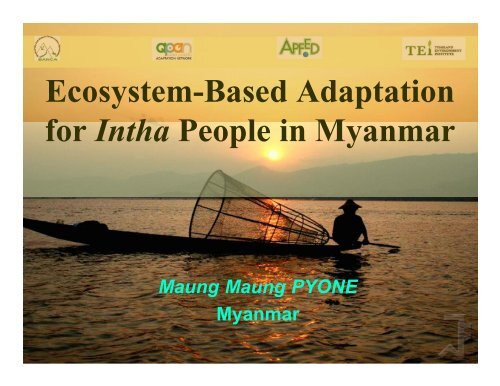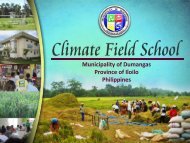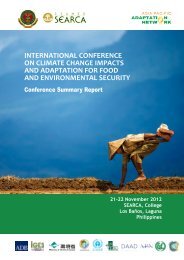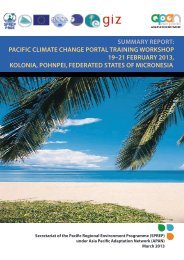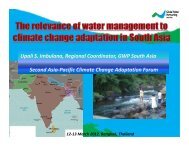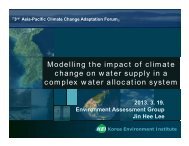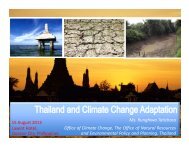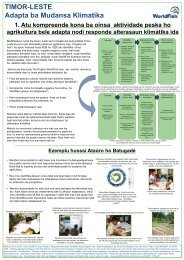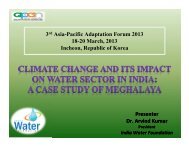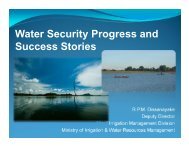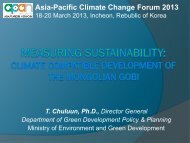Ecosystem-Based Adaptation for Intha People in Myanmar - Asia ...
Ecosystem-Based Adaptation for Intha People in Myanmar - Asia ...
Ecosystem-Based Adaptation for Intha People in Myanmar - Asia ...
Create successful ePaper yourself
Turn your PDF publications into a flip-book with our unique Google optimized e-Paper software.
<strong>Ecosystem</strong>-<strong>Based</strong> <strong>Adaptation</strong><br />
<strong>for</strong> <strong>Intha</strong> <strong>People</strong> <strong>in</strong> <strong>Myanmar</strong><br />
Maung Maung PYONE<br />
<strong>Myanmar</strong>
Contents<br />
1<br />
2<br />
3<br />
4<br />
5<br />
Inle Lake and <strong>Intha</strong> <strong>People</strong><br />
Problems Fac<strong>in</strong>g <strong>in</strong> Inle Lake<br />
Action Undertaken<br />
Participation of <strong>Intha</strong> <strong>People</strong><br />
Conclusion
Inle Lake is<br />
Second largest freshwater lake <strong>in</strong><br />
<strong>Myanmar</strong><br />
<br />
Located <strong>in</strong> Southern Shan State<br />
Depth rang<strong>in</strong>g from 2m-6m<br />
Water Area 130-150 Square Kilometers<br />
Catchment area is about 3600 Sqkilometers<br />
Altitudes about 900m above sea level<br />
Included <strong>in</strong> Protected Area System PAS<br />
of <strong>Myanmar</strong><br />
Lists of UNESCO World Heritage Site<br />
Asean Cultural Heritage Site<br />
Potential RAMSAR (Conservation on<br />
Wetland Association) site<br />
Important Bird Area (IBA)
Inlay Lake is one of the famous tourist attraction<br />
places of <strong>Myanmar</strong>
We can See Fancy Goldfishes <strong>in</strong> Inlay lake
Habitat of IUCN Red-listed Species
Inlay Lake is the Home of the Water-birds<br />
90<br />
BIRD SURVEY (2001-2009)<br />
80<br />
70<br />
60<br />
No. of Species<br />
50<br />
40<br />
Forest Birds<br />
Water Birds<br />
30<br />
20<br />
10<br />
0<br />
2001 2002 2003 2004 2005 2006 2007 2008 2009
Humans and Animals Live Harmony <strong>in</strong> Inle lake
<strong>Intha</strong> <strong>People</strong> <strong>in</strong> Inle Lake
<strong>Intha</strong> <strong>People</strong> Has its Unique Culture
Float<strong>in</strong>g Agriculture is Major Source of Income <strong>for</strong> <strong>Intha</strong>
Fish<strong>in</strong>g is an Important Livelihood <strong>for</strong> <strong>Intha</strong> <strong>People</strong>
Phaungtawu Pagoda Festival <strong>in</strong> Inle Lake
Now Inlay Lake is fac<strong>in</strong>g with<br />
Climate Change Problems<br />
2010 April
Shr<strong>in</strong>kage of Water Area
Shallow Water <strong>in</strong> the Waterway
9.2<br />
9<br />
8.8<br />
8.6<br />
8.4<br />
8.2<br />
8<br />
7.8<br />
7.6<br />
7.4<br />
7.2<br />
W.S.1 W.S.2 W.S.3 W.S.4 W.S.5
Health Problems<br />
Sr.<br />
Types of<br />
Sample<br />
May, 1995<br />
(Float<strong>in</strong>g Garden<br />
Season)<br />
No. of<br />
Samples<br />
Pollutant<br />
Samples<br />
%<br />
Jan, 1996<br />
( Float<strong>in</strong>g Garden<br />
Villages )<br />
No. of<br />
Samples<br />
Pollutant<br />
Samples<br />
%<br />
Jan, 1996<br />
(No Float<strong>in</strong>g Garden<br />
Villages)<br />
No. of<br />
Samples<br />
Pollutant<br />
Samples<br />
%<br />
1. Blood 120 29 24.3 501 38 7.6 321 17 5.3<br />
2. Water 7 4 57.1 7 4 57.1 7 1 14.3<br />
3. Weed 3 1 33.3 3 1 33.3 3 1 33.3<br />
4. Silt 3 3 100 3 3 100 3 3 100<br />
5. Vegetable 5 1 20 5 1 20 - - -<br />
Remark:<br />
Numbers <strong>in</strong> Blue = no float<strong>in</strong>g garden village
Threaten on Native Species due to Changes of <strong>Ecosystem</strong><br />
4.<br />
Cypr<strong>in</strong>us <strong>Intha</strong><br />
March 2010
Occurrence of Invasive Species
Causes of Climate Change
Shift<strong>in</strong>g Cultivation <strong>in</strong> Watershed Area<br />
22
High Fuel-wood Consumption
Soil Deteriorat<strong>in</strong>g <strong>in</strong> Hilly Region
Chemical fertilizers and Industrial waste
Integrated multi-stakeholder ecosystem framework<br />
<strong>for</strong> Inle Lake (<strong>Myanmar</strong>) based on Zon<strong>in</strong>g<br />
pr<strong>in</strong>ciples with Integration of Eco-restoration and<br />
Agro-farm<strong>in</strong>g Practices)<br />
Implement<br />
Zon<strong>in</strong>g Pr<strong>in</strong>ciple<br />
Form<strong>in</strong>g<br />
VLRT<br />
Introduce<br />
Organic<br />
Farm<strong>in</strong>g
Participatory Mapp<strong>in</strong>g <strong>for</strong> <strong>Intha</strong> to <strong>for</strong>mulate Zon<strong>in</strong>g Plan<br />
Take assessment of<br />
villagers’ needs<br />
Formulate their ideas to<br />
conserve lake environment<br />
Sketch on the proposed<br />
zones <strong>in</strong> the map<br />
Discuss briefly advantages<br />
and disadvantages of<br />
proposed zone<br />
Decide draft plan of zon<strong>in</strong>g<br />
area and plan<br />
Propose VLRT teammembers<br />
and their duties<br />
Laid down plan <strong>for</strong> way<br />
<strong>for</strong>wards<br />
<br />
Map of 2 Project Sites
Demarcation of Zon<strong>in</strong>g Pr<strong>in</strong>ciple<br />
The proposed zon<strong>in</strong>g area was demarcated <strong>in</strong><br />
the 50,000 scale UTM map and covered Sitha<br />
and In-U villages.<br />
Mapp<strong>in</strong>g of the Zone<br />
The zon<strong>in</strong>g Map <strong>in</strong>dicated the follow<strong>in</strong>g<br />
zones allow<strong>in</strong>g different degree of activities:<br />
Core Conservation Zone<br />
Buffer Zone<br />
Susta<strong>in</strong>able Use Zone<br />
General use Zone<br />
Village Use Zone<br />
Strict bio-diversity<br />
conservation<br />
Limited activities allowed<br />
Susta<strong>in</strong>able resources use<br />
(fish<strong>in</strong>g, agro-farm<strong>in</strong>g)
Form<strong>in</strong>g Two Village Lake Restoration Team VLRT<br />
March 2010
Participation of <strong>Intha</strong> <strong>People</strong><br />
Designed an action plan<br />
Design<strong>in</strong>g environment friendly<br />
waste management<br />
Plant harvest<strong>in</strong>g to clean up parts of<br />
the lake and the waterways<br />
Patroll<strong>in</strong>g <strong>for</strong> poach<strong>in</strong>g and illegal<br />
extraction of resources<br />
March 2010<br />
Conduct<strong>in</strong>g environmental education<br />
activities
Introduce Organic Farm<strong>in</strong>g <strong>for</strong> <strong>Intha</strong> <strong>People</strong><br />
March 2010
Ma<strong>in</strong><br />
Project<br />
Impacts <strong>for</strong><br />
Impacts<br />
<strong>Intha</strong> <strong>People</strong>
Increased Sense of Ownership of Local <strong>People</strong><br />
The ma<strong>in</strong> issue of the Inle lake is the scarcity of<br />
natural resources due to mismanagement.<br />
All of the natural resources has been also threatened<br />
by the pressure of high population.<br />
Zon<strong>in</strong>g plan can create proper conservation of lake<br />
area and ma<strong>in</strong>ta<strong>in</strong> natural resources <strong>for</strong> susta<strong>in</strong>able<br />
production.<br />
Zon<strong>in</strong>g plan will be ma<strong>in</strong>ta<strong>in</strong>ed lake eco-system and<br />
ensured to food security of the people.<br />
Introduc<strong>in</strong>g zon<strong>in</strong>g plan is not only useful to<br />
ma<strong>in</strong>ta<strong>in</strong> lake eco-system but also <strong>for</strong> the villagers to<br />
protect their neighbor<strong>in</strong>g area from encroachment of<br />
other people.
Improved Teamwork to participate<br />
Traditionally they are grouped <strong>for</strong> deal<strong>in</strong>g of their social<br />
ceremony like donation period.<br />
There has been no official demarcation <strong>in</strong> the area to make<br />
fish<strong>in</strong>g <strong>in</strong> previous time.<br />
There are a lot of <strong>in</strong>truders of fishermen and bird-hunters <strong>in</strong><br />
their area.<br />
They are eager to ma<strong>in</strong>ta<strong>in</strong> their land <strong>for</strong> long-term use of<br />
resources.<br />
The villagers were active to participate <strong>in</strong> conserv<strong>in</strong>g their<br />
surround<strong>in</strong>g area.<br />
Now they have a chance to manage their land with sufficient<br />
group of people.<br />
They also have experiences to conserve their natural<br />
environment with VLRT group.
Initiated to healthy food Production<br />
They traditionally know that the us<strong>in</strong>g of<br />
chemical fertilizer is the best method to<br />
<strong>in</strong>crease tomato production.<br />
Now they know that organic farm<strong>in</strong>g is the best<br />
way to create healthy food <strong>for</strong> their long-lives.<br />
Some of them now try to produce eco-food <strong>for</strong><br />
their daily consumption.<br />
It is the best <strong>in</strong>itiative <strong>for</strong> healthy environment.


